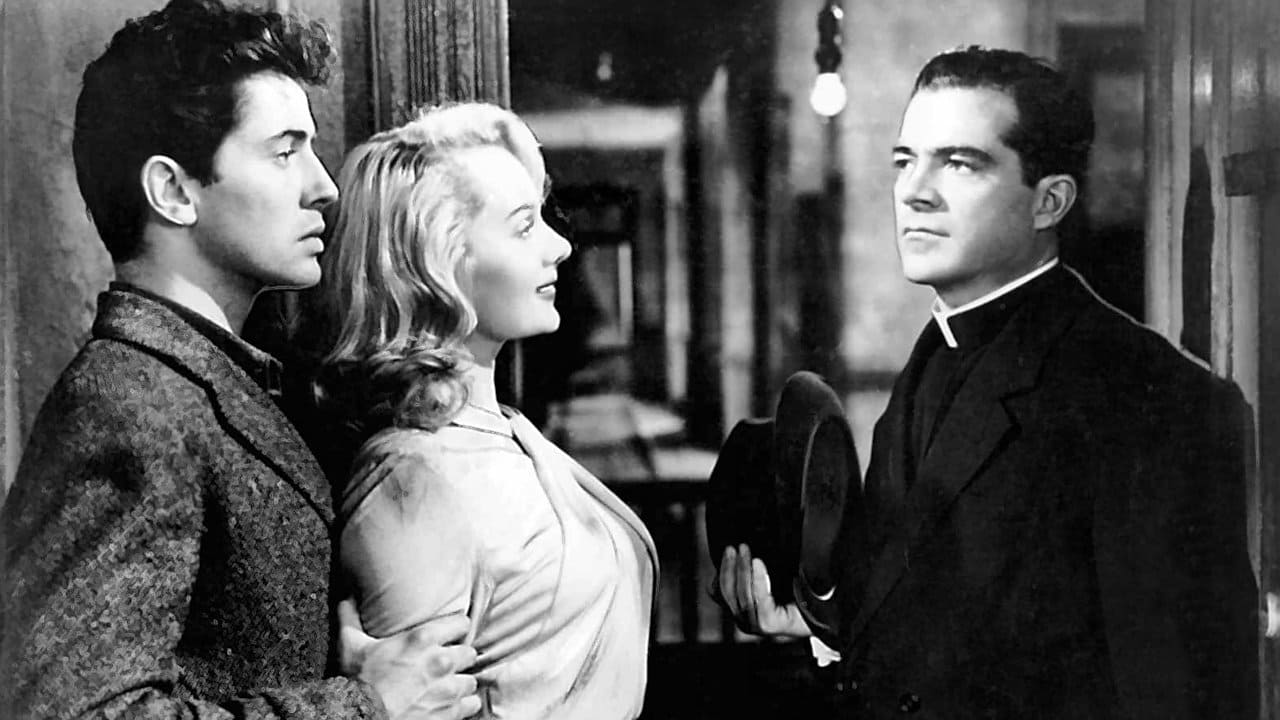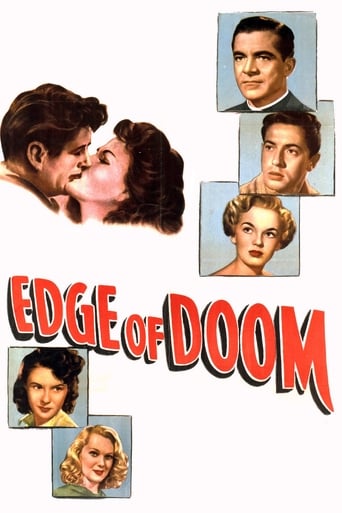



Save your money for something good and enjoyable
Lack of good storyline.
if their story seems completely bonkers, almost like a feverish work of fiction, you ain't heard nothing yet.
View MoreEach character in this movie — down to the smallest one — is an individual rather than a type, prone to spontaneous changes of mood and sometimes amusing outbursts of pettiness or ill humor.
View MoreDana Andrews (Father Roth), Farley Granger (Martin Lynn), Joan Evans (Rita Conroy), Robert Keith (Mandel), Paul Stewart (Craig), Mala Powers (Julie), Adele Jergens (Irene), Harold Vermilyea (Father Kirkman), John Ridgely (1st detective), Douglas Fowley (2nd detective), Mabel Paige (Mrs Pearson), Howland Chamberlain (Mr Murray), Houseley Stevenson, Sr (Mr Swanson), Jean Innes (Mrs Lally), Ellen Corby (Mrs Moore), Ray Teal (Ned Moore), Mary Field (Mary Jane Glennon), Virginia Brissac (Mrs Dennis), Frances Morris (Mrs Lynn).Directed by MARK ROBSON. Screenplay: Philip Yordan. Based on the novel by Leo Brady. Music director: Emil Newman. Score: Hugo Friedhofer. Photographer: Harry Stradling. Editor: Daniel Mandell. Art director: Richard Day. Costumes: Mary Wills. Set decorator: Julia Heron. Make- up: Blagoe Stephanoff. Hair styles: Marie Clark. Additional scenes directed by Charles Vidor, written by Ben Hecht. Sound recording: Fred Lau. Producer: Samuel Goldwyn.Copyright 3 August 1950 by Samuel Goldwyn Productions, Inc. Released by RKO Radio Pictures. New York opening at the Astor: 3 August 1950. U.S. release: 30 September 1950. U.K. release: December 1951. Australian release: 16 August 1951. 99 minutes.U.K. release title: STRONGER THAN FEAR.SYNOPSIS: "It's simple story about a boy who wants a fine funeral for his mother, so he kills a priest." — Sam Goldwyn, explaining the plot to an eager group of journalists.NOTES: After its New York opening, Goldwyn rejigged the movie by adding narration, plus a prologue and epilogue, written by Charles Brackett and Ben Hecht, directed by Charles Vidor. Even with the additional scenes, the movie still came in at 96 minutes — 3 minutes less than before. Considerable excisions were made. Some of the most powerful episodes were deleted altogether, whilst others, notably the undertaker's sequence, were unmercifully diluted.VIEWERS GUIDE: Adults.COMMENT: This film is not now available in its original form but, whether called "Edge of Doom" or "Stronger Than Fear" (its U.K. release title), in a version somewhat mutilated by the addition of a fatuous prologue and epilogue and a patronizing commentary, all written by Ben Hecht and flatly directed by Charles Vidor.In its present state, the movie's entertainment quotient hasn't been increased, but lessened. Nonetheless, there are still features of interest to the connoisseur. The scene in which Harold Vermilyea is murdered still comes across with considerable force. The driving pace of Robson's direction, the moody black-and-white photography of Harry Stradling, the fine sets of art director Richard Day and some very good performances, particularly Vermilyea, Keith and Stewart, plus incisive dialogue are all positive recommendations.Offsetting all these is the glum performance of Dana Andrews, whilst Farley Granger makes an unlikely hero. Mala Powers is also very weak as the hero's girlfriend. And then there's that commentary!OTHER VIEWS: Whatever induced that normally astute showman Sam Goldwyn to attempt a film of Leo Brady's morbid novel? (Some sources say it was his wife, a convert to Catholicism). Whatever, Sam parted up with no less than $150,000 just for the film rights. He then ripped the guts out of the book by casting Dana Andrews as the priest. What few virtues Mr Andrews has as an actor — doggedness, certainly — neither sincerity nor saintliness, let alone spiritual strength, figure in that short list. Not that Farley Granger was any more charismatic, but at least his weakness was right for the role. As for the movie itself, even the re-edited light version is still mighty heavy going. — JHR writing as George Addison.
View MoreExcellent, truly depressing, forgotten noir starring Farley Granger. He plays a young man who's had an incredibly difficult life: he has grown up poor. His father, when he was a teenager, committed suicide after committing a robbery. The church denied providing any services for his father and basically told Granger and his mother that the guy was doomed to rot in Hell. Granger's mom was too religious to give it up, but Granger holds a powerful grudge for the church. The film opens with his mother dying, and Granger has to honor his mother's final wishes by going to the church to get her a funeral. A big one, he insists, because she never had anything good in life. Unfortunately, the priest his mother trusts (Dana Andrews) is out on a call, and he is forced to deal with the same priest (Harold Vermilyea) who denied his father a proper burial. This agitates Granger so much, he ends up committing a horrible crime. Andrews is quicker to understand the truth than the police, so he tries to get Granger to turn himself in before he gets himself in more trouble. Both Granger and Andrews are very good in their roles, and Mark Robson, who previously directed several horror films in the Val Lewton cycle, does an excellent job ratcheting up the suspense. This was kind of a bomb on its first release. It perhaps was too dark, even for the genre. Farley Granger didn't think it was very good, but he was wrong. He should have been proud of it. You can find this film right now on Netflix Instant. It was on VHS, but has never been on DVD.
View MoreEdge of Doom (1950)It would be hard to find a movie as unrelentingly dark and brooding as this one. Everyone from the priest to the hero's mother, from the sweet girlfriend to the neighbor down the hall is burdened with the pain of everyday life. Most of the scenes at night, too, or inside dark rooms and hallways, or both, so the shadowy world only descends lower. And this is partly what makes it really work. Dana Andrews is a worldly, reflective priest in a tale of redemption, actually, against all this gloom. The protagonist is a young Farley Granger, who gets in trouble from a single rash act, and is in a tailspin for the rest of the movie. From one shadowy scene to another, running through dark streets or hiding in a dingy apartment, Granger has to face his inner demon.But Granger, like Andrews, is a thoroughly decent person inside, and the movie, despite all the negative vibes, is about faith and goodness. Director Mark Robson is not a big name, of course, but he paid his dues with some of the best--Robert Wise and Val Lewton. And he came out of an era of Hollywood that was uncompromising in its technical quality. It shows. This is a movie with a single main theme, and if it has impassioned acting and high dramatics (at times) it also is gritty and single minded, too. The plot is packaged too neatly, and littered with Andrews narrating through the long flashback. That's its one limitation--that it's limited. But what it does do it does with real intensity.
View MoreWhen Edge of Doom was first released, audiences turned away from it with the coldest of shoulders. It was yanked out of circulation so that a pair of bookends could be shot, in which the story becomes a kind of parable told by a wise old rector (Dana Andrews) to a younger priest undergoing a pastoral crisis. The filmmakers shouldn't have bothered: Edge of Doom remains one of the bleakest, least comforting offerings of the entire noir cycle (no mean feat), and probably the most irreligious movie ever made in America. When Farley Granger's devout but tubercular mother dies, it precipitates a rampage against everything that makes up the prison of his life: his ugly urban poverty; his penny-pinching employer who offers promises rather than a raise; the Church, which once refused burial to his father, a suicide, and is now refusing his mother the "big" funeral he thinks he owes her; the smarmy, sanctimonious undertaker. Long story short, he ends up murdering a crusty, hell-and-brimstone priest. The police nab him for a robbery he didn't commit but end up with a different murder suspect. But compassionate pastor Dana Andrews (now in flashback) suspects the truth.... There's something almost endearingly Old Left about the savagery of the indictment leveled against society's Big Guns: Church, police and capitalism. The slum where Granger lived with his mother makes Ralph and Alice Kramden's Chauncey Street digs in Brooklyn look cozily inviting (Adele Jergens, as the slatternly wife of a neighbor, observes, "Smart people don't live here"); outside, the nighttown is noir at its most exhilaratingly creepy. It's easy to see why the public, on the cusp of the fabulous fifties, shunned this movie, whose unprettiness is uncompromised. But it's as succinct a summing up of the noir vision as anything in the canon.
View More